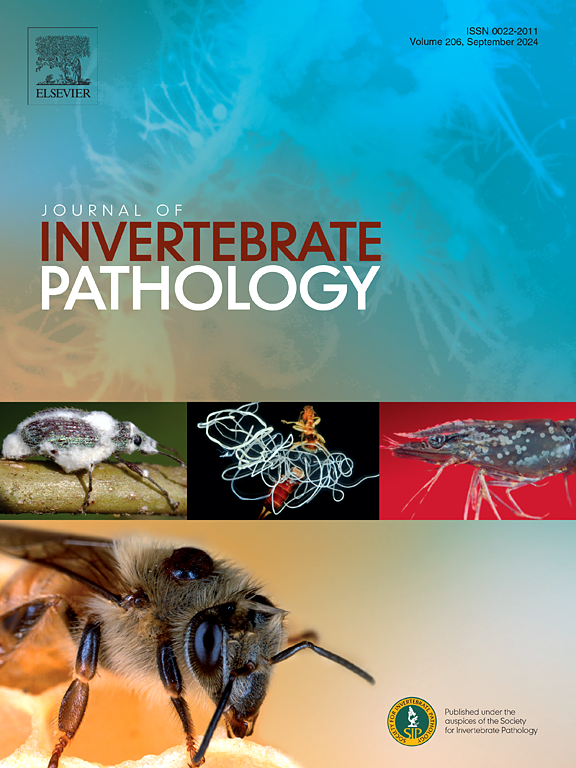同胞寄主会庇护同胞寄生虫吗?1949年墨西哥太平洋西北部聚集绦虫感染匹克福德和麦康纳章鱼的病例
IF 2.4
3区 生物学
Q1 ZOOLOGY
引用次数: 0
摘要
Aggregata属包括世界性的顶复合体寄生虫,感染头足类动物,并表现出高度的宿主特异性。它们的异质性生命周期需要两个寄主:甲壳类(单性生殖)和头足类(单性生殖/孢子生殖)。Poynton et al.(1992)报道了来自美国加利福尼亚的章鱼(Octopus biacaculoides)中存在千叶聚合体(Aggregata millerorum),并描述了孢子囊表面的光滑。在本研究中,在下加利福尼亚州Ensenada采集的8只O. bimaculoides中,有4只携带Aggregata sp.,其孢子囊上的分叉管状突起与加利福尼亚湾双爪章鱼(Octopus biaculatus)中Aggregata polibraxiona相似。因此,Aggregata sp.(目前的研究)和A. polibraxiona(来自加利福尼亚湾)可能是同一物种。我们采用形态学、组织学和分子学的方法描述和鉴定了居住在Ensenada的O. bimaculoides中的Aggregata sp.。Aggregata sp.(本研究)和A. polibraxiona的孢子囊表面具有管状分叉突起,但孢子囊(10-18 vs 12-24µm)和孢子子(11-18 vs 16-26µm)的大小不同。对部分18S rDNA序列的系统发育分析表明,感染双棘球绦虫和双棘球绦虫的Aggregata种属于同一进化支,表明缺乏系统发育信息。需要更多的18S rDNA数据来澄清来自Ensenada港的a . polibraxiona的O. bimaculoides是否被多个Aggregata物种共同感染,或者宿主是一个新物种。这项工作强调了整合分类在聚合属研究中的重要性,以及开发新的分子标记(如ITS和COX)来加强种水平分类的必要性。本文章由计算机程序翻译,如有差异,请以英文原文为准。

Do sibling hosts harbor sibling parasites? The case of Aggregata sp. (Apicomplexa: Aggregatidae) infecting Octopus bimaculoides Pickford and McConnaughey, 1949 in the northwest Mexican Pacific
The genus Aggregata comprises cosmopolitan Apicomplexa parasites that infect cephalopods and show high host specificity. Their heteroxenous life cycle requires two hosts: a crustacean (merogony) and a cephalopod (gamogony/sporogony). Poynton et al. (1992) reported Aggregata millerorum in Octopus bimaculoides from California (USA) and described the smoothness of the sporocyst surface. In this study, four of eight O. bimaculoides collected in Ensenada, Baja California, harbored Aggregata sp. showing bifurcate tubular projections on sporocysts similar to those of Aggregata polibraxiona, which was described in Octopus bimaculatus from the Gulf of California. Thus, Aggregata sp. (present study) and A. polibraxiona (from the Gulf of California) may be the same species. We employed morphological, histological, and molecular approaches to describe and identify Aggregata sp. inhabiting O. bimaculoides from Ensenada. The sporocyst surfaces of Aggregata sp. (present study) and A. polibraxiona shared tubular bifurcated projections but differed in the sizes of the sporocysts (10–18 vs 12–24 µm) and sporozoites (11–18 vs 16–26 µm). Phylogenetic analyses of partial 18S rDNA sequences placed both Aggregata species infecting O. bimaculatus and O. bimaculoides in the same clade, indicating a lack of phylogenetic informativeness. Additional 18S rDNA data are needed to clarify whether O. bimaculoides from Ensenada harbor A. polibraxiona, are co-infected by multiple Aggregata species, or host a novel species. This work highlights the importance of integrative taxonomy in studies of Aggregata species and the need to develop novel molecular markers (e.g., ITS and COX) to enhance species-level classification.
求助全文
通过发布文献求助,成功后即可免费获取论文全文。
去求助
来源期刊
CiteScore
6.10
自引率
5.90%
发文量
94
审稿时长
1 months
期刊介绍:
The Journal of Invertebrate Pathology presents original research articles and notes on the induction and pathogenesis of diseases of invertebrates, including the suppression of diseases in beneficial species, and the use of diseases in controlling undesirable species. In addition, the journal publishes the results of physiological, morphological, genetic, immunological and ecological studies as related to the etiologic agents of diseases of invertebrates.
The Journal of Invertebrate Pathology is the adopted journal of the Society for Invertebrate Pathology, and is available to SIP members at a special reduced price.

 求助内容:
求助内容: 应助结果提醒方式:
应助结果提醒方式:


